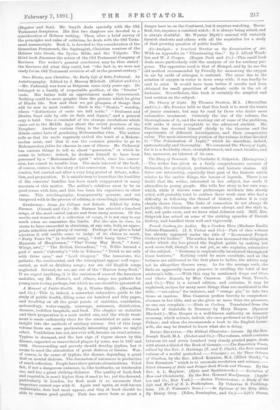A Manual of Public Health. By A. Winter Blyth. (Macmillan
and Co.)—This is, indeed, a somewhat exhaustive guide to the study of public health, filling some six hundred and fifty pages, and touching on all the great points of statistics, ventilation, meteorology, water-supply, sewerage, nuisances, disinfection, diseases, isolation hospitals, and food. The chapter on statistics and their preparation is a most useful one, and the whole treat- ment is made sufficiently clear for the uninitiated to gain some insight into the methods of sanitary science. Out of this large volume there are some particularly interesting points we might select. Ventilation has not, nor over will, become an exact science. Typhus is dormant, and the last sign of vigour shown by this disease, regarded as emasculated plague by some, was in 1887 and 1889. Overcrowding and poverty should develop typhus, but it seems to need the stimulation of great distress or famine. War, of course, is the cause of typhus, the disease depending a great deal on mental distress. The discussion of nuisances is productive of much reflection. People have their private abominations. Fried fish, if not a dangerous nuisance, is, like toothache, an intolerable one, and has a great striking-distance. The quality of food, flesh and vegetable, is much higher than it used to be ; yet the demand, particularly in London, for flesh moat is so enormous that inspectors cannot cope with it. Again and again, at well-known restaurants, does bad meat appear, and they at least should be able to ensure good quality. Pork has never been so great a
danger here as on the Continent, but it requires watching. Horse- flesh, too, requires a constant watch ; it is always being seized, and is always doubtful. Mr. Wynter Blyth's manual will certainly furnish students and others with all the requisites for a study of that growing question of public health.










































 Previous page
Previous page